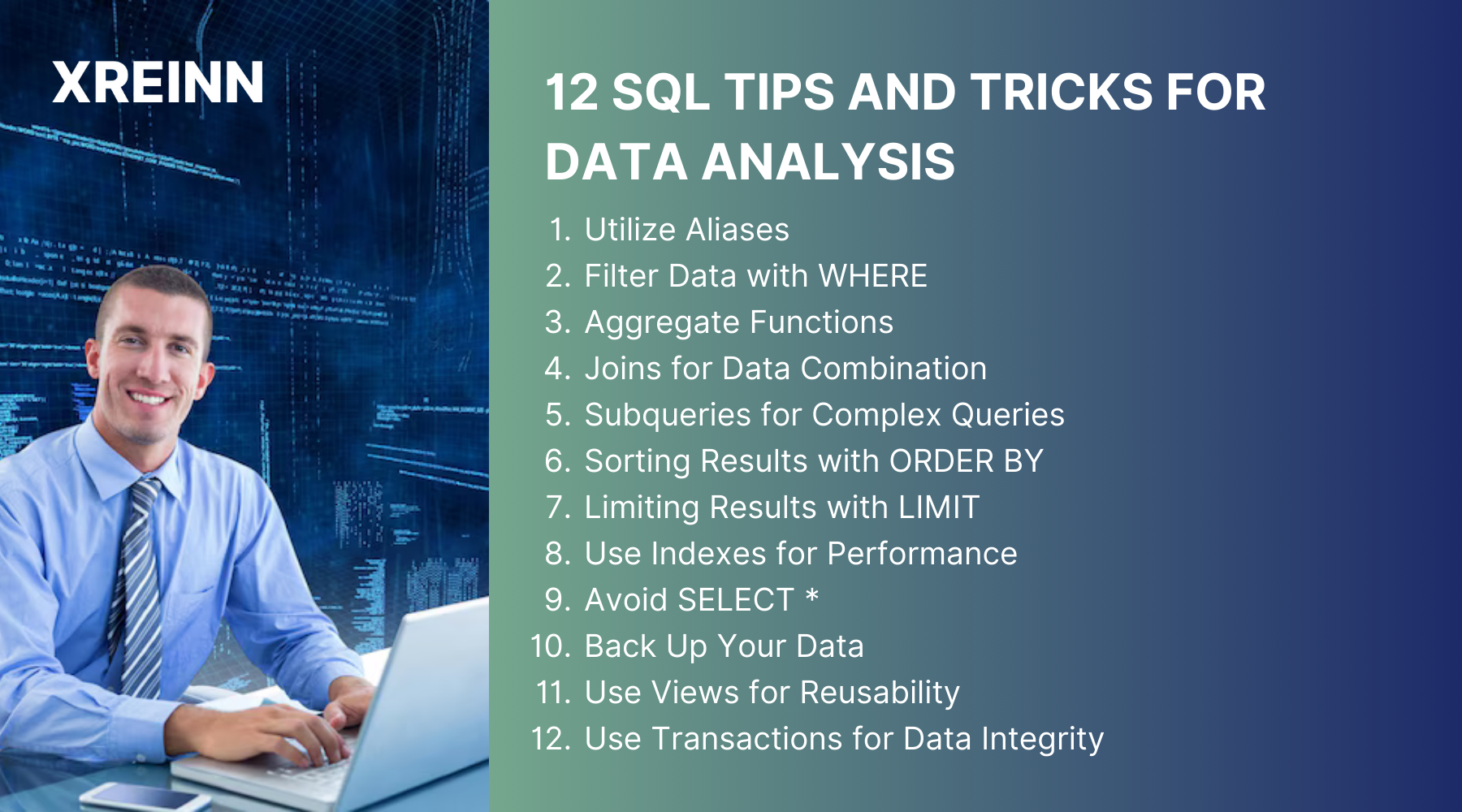Data Analytics
Top 12 SQL Tips and Tricks for Effective Data Analysis
Jul 08, 2024
SQL (Structured Query Language) is a powerful tool that enables efficient data manipulation and retrieval from relational databases. It allows users to execute queries, update records, and manage database structures. With SQL, you can analyze large datasets, generate meaningful reports, and gain valuable insights. Utilizing SQL effectively can lead to improved operational efficiency, better strategic planning, and enhanced data-driven decision-making.
SQL (Structured Query Language) is a powerful tool for individuals learning data analytics and SQL. It facilitates efficient manipulation and retrieval of data from relational databases, enabling users to execute queries, update records, and manage database structures. Mastering SQL empowers learners to analyze large datasets, generate reports, and uncover valuable insights.
In this article, we will cover 12 SQL tips and tricks that can enhance your data analysis skills, helping you extract valuable insights and make informed decisions.
Let's jump in and see how SQL can help with data analysis.
What is SQL?
SQL or Structured Query Language, is a powerful and essential tool used in managing and manipulating relational databases. Since its inception in the 1970s, SQL has become the standard language for interacting with databases, enabling users to perform a wide range of data operations. It allows for the querying, updating, and organizing of data efficiently.
SQL is widely used in various applications, from simple data retrieval to complex data analysis, making it a cornerstone of modern data management.
12 Tips and Tricks for Effective Data Analysis

1. Utilize Aliases
Aliases provide an accessible way to rename columns or tables within your SQL queries, making your code more readable and maintainable. Using aliases helps clarify your queries, making them easier to understand and manage. This simple renaming can significantly reduce the complexity of your queries, especially when dealing with multiple tables or columns with similar names. Aliases also make your results more user-friendly by providing meaningful names to the columns.
For example:
SELECT e.employee_name AS Name, d.department_name AS Department
FROM employees AS e
JOIN departments AS d ON e.department_id = d.department_id;
2. Filter Data with WHERE
The WHERE clause allows you to filter data based on specific conditions, helping you focus on relevant information. For instance:
SELECT *
FROM sales
WHERE sale_date >= '2023-01-01' AND sale_date <= '2023-03-31';
This approach narrows down your results, making your analysis more targeted and effective. Filtering data with the WHERE clause ensures that you only retrieve the data you need, which improves query performance and reduces processing time. It also helps to maintain data integrity by excluding irrelevant data points.
3. Aggregate Functions
Aggregate functions perform calculations on groups of data, providing insights such as totals, averages, and counts. Common aggregate functions include COUNT, SUM, AVG, MIN, and MAX. For example, to calculate the total sales amount:
SELECT SUM(sale_amount) AS TotalSales
FROM sales;
These functions are invaluable for summarizing large datasets and identifying trends. By using aggregate functions, you can quickly derive meaningful statistics from your data, which can inform strategic decisions and highlight significant patterns. Aggregates help in creating summary reports and dashboards.
4. Joins for Data Combination
Joins allow you to combine data from multiple tables based on a common column. This is particularly useful for integrating different datasets. For example, to retrieve customer information along with their purchase details:
SELECT c.customer_name, p.product_name, o.quantity
FROM customers AS c
JOIN orders AS o ON c.customer_id = o.customer_id
JOIN products AS p ON o.product_id = p.product_id;
Using joins helps you create comprehensive views of your data, enabling more holistic analysis. Joins can reveal relationships between different data entities, facilitating in-depth analysis and richer insights. They are essential for creating complex queries that span multiple data sources.
5. Subqueries for Complex Queries
Subqueries allow you to break down complex problems into simpler ones by nesting queries within queries. For example, to find customers who have made more than five purchases:
SELECT customer_name
FROM customers
WHERE customer_id IN (
SELECT customer_id
FROM orders
GROUP BY customer_id
HAVING COUNT(*) > 5
);
This method simplifies complex data retrieval tasks, making your queries more manageable. Subqueries enable you to solve problems step-by-step, isolating different parts of the query logic. They can be used in SELECT, FROM, WHERE, and HAVING clauses, offering flexibility in query construction.
6. Sorting Results with ORDER BY
The ORDER BY clause lets you sort your query results in ascending or descending order based on one or more columns. For instance:
SELECT product_name, unit_price
FROM products
ORDER BY unit_price DESC;
Sorting your data helps you quickly identify key trends and outliers, making your analysis more insightful. It also enhances the readability of your results by organizing them in a meaningful order. Sorting can be crucial when preparing reports or presentations that require data to be displayed in a specific sequence.
7. Limiting Results with LIMIT
The LIMIT clause is useful when you only need to retrieve a specific number of rows from your query results. For example, to fetch the top 10 highest-earning employees:
SELECT employee_name, salary
FROM employees
ORDER BY salary DESC
LIMIT 10;
Limiting results helps you focus on the most relevant data, streamlining your analysis. It is especially helpful in performance tuning by reducing the amount of data processed and displayed. Using LIMIT ensures that your queries run faster and consume fewer resources, which is beneficial in large databases.
8. Use Indexes for Performance
Indexes improve query performance by allowing quicker data retrieval. Identify columns frequently used in WHERE clauses or joins and create indexes on them. For example:
CREATE INDEX idx_product_name
ON products (product_name);
Using indexes can significantly speed up your queries, enhancing overall database performance. Indexes reduce the time required to search and sort data, making your queries more efficient. Proper indexing is essential for maintaining high performance in databases with large datasets or complex query requirements.
9. Avoid SELECT *
Instead of using SELECT * to fetch all columns, explicitly specify the columns you need. This reduces unnecessary data transfer and improves query performance. For example:
SELECT employee_name, department_name
FROM employees;
This practice makes your queries more efficient and easier to understand, reducing processing time and resource usage. By selecting only the required columns, you minimize the amount of data processed and transmitted, which can improve the performance of your application or report.
10. Back Up Your Data
Regularly backing up your databases prevents data loss. Use appropriate backup strategies like full backups, incremental backups, or automated backup solutions, depending on your requirements. Regular backups ensure that you can recover your data in case of any issues, safeguarding your valuable information.
11. Use Views for Reusability
Views in SQL are virtual tables created by storing the result of a SELECT query. They provide a way to save complex queries that can be reused without rewriting the entire SQL statement. For example:
CREATE VIEW EmployeeSales AS
SELECT e.employee_name, s.sale_amount
FROM employees AS e
JOIN sales AS s ON e.employee_id = s.employee_id;
Using views simplifies complex query execution and improves code maintainability. They abstract the complexity of your queries, making your code cleaner and more understandable. Views also provide a level of security by restricting access to specific data.
12. Use Transactions for Data Integrity
Transactions allow you to execute a series of SQL statements as a single unit of work, ensuring data integrity and consistency. This is particularly useful for operations that involve multiple changes to the database. For example:
BEGIN TRANSACTION;
UPDATE accounts
SET balance = balance - 100
WHERE account_id = 1;
UPDATE accounts
SET balance = balance + 100
WHERE account_id = 2;
COMMIT;
If any statement within the transaction fails, you can roll back all the changes to maintain data integrity. Using transactions ensures that either all changes are applied or none are, preventing partial updates and maintaining consistency.
Conclusion
By implementing these 12 SQL tips and tricks, you can enhance your data analysis skills and streamline your workflow. SQL’s versatility allows you to handle complex queries, filter data efficiently, and gain valuable insights for better decision-making. Aliases, WHERE clauses, aggregate functions, joins, subqueries, ORDER BY, LIMIT, indexes, views, and transactions are powerful tools that can transform your data analysis efforts.
Start applying these tips today to optimize your database interactions and make your analyses more efficient and impactful, helping your SME thrive in a competitive market.

Data Analytics
Jun 27, 2024Master key concepts in data analytics with practical tips to enhance decision-making and achieve success in your projects and professional growth

Data Analytics
Jul 01, 2024Learn the essential stages of the data analytics workflow to turn your data into valuable business insights and drive growth.

